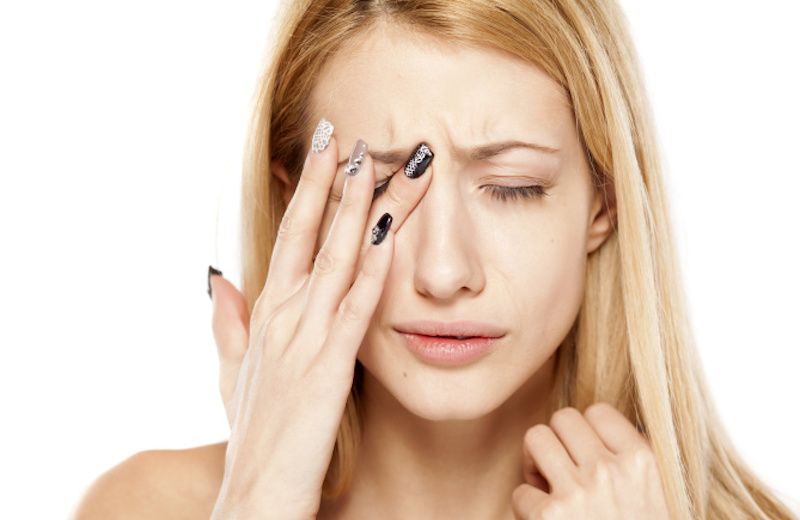Eye styes are fairly common, and most people will experience one or two of them within their lifetime. A stye can occur for different reasons but they are most commonly caused by a type of bacteria called staphylococcal bacteria. This bacteria is constantly on the surface of your skin, but when conditions are right it can cause an infection such as a stye. A stye is a small, somewhat painful lump that will occur either on the inside or outside of the eyelid. They are contagious, but the bacteria that causes them occurs naturally on most people’s body already. If someone has a stye it is perfectly okay to interact with them, you just don’t want to touch or contact the infected person’s eyes.
There are two main types of styes, internal styes and external stye. An external stye will last for a short time and then it bursts. After it bursts, it heals rather quickly. Both types of styes are relatively short-lived. They will appear next to an eyelash and become red and start to swell shortly after. An internal stye is located on the underside of the eyelid and won’t be as visible; it will still be red, painful, and swelled up. Styes are usually quite harmless and won’t really impact your vision or be detrimental to your overall health. You should not try to pop a stye as if it were a pimple, you need to let it rupture by itself. They can occur within any type of people, at any age, and they can reoccur periodically as well. There are 6 different symptoms which can help you to identify whether or not you have a stye.

1. Puffy Eyes
When your eyes begin to feel puffy it can be one of the first signs that you may have a stye that is developing. The term puffy can also be interchanged with the word swollen. Puffy eyes can occur for a number of reasons, but they are a sign that your eyes are being discomforted. The discomfort can be from allergies, an infection, or an injury of the eye. Many times due to your eyes becoming swollen, they will also begin to water. Watery eyes is the next symptom that can be noticed when you begin to develop a stye. These two symptoms are often intertwined.
2. Watery Eyes
As already mentioned, watery eyes is another common symptom that will develop if you have a stye. Part of the reason that the eyes begin to water more often is that of your eyes swelling. The swelling of the eyes will place pressure on your eyelids causing them to water more often than they normally would. The infected eye will produce excess tears as well because it is trying to rinse out the irritation to the eye. One of the body’s natural defenses against infection is its tears. Tears act kill and disinfect different germs and objects that come into contact with the surface of your eyes.
3. Lump on the Eyelid
A lump on the eyelid will become quite visible as the stye develops. If the stye is an internal stye, it will be less visible, but you will still notice a lump. The lump will be red and develop near the edge of your eyelid underneath your eyelashes. If the stye is an external stye, you will notice that it may develop in a similar manner to a pimple. You should not try to pop the stye because it may contain fluid, and squeezing it will just cause further irritation. The stye will pop on its own and will heal after that.
4. Eyelid Tenderness
Eyelid tenderness is one of the more specific symptoms that will help you differentiate a stye from other eye swelling causes such as allergies. The eyelid which contains the stye will begin feeling swollen and soar. There won’t be any tenderness in the eyelid of the non-affected eye. Even though the eyelid is tender and sore, you should avoid touching it. The bacteria are contagious and will be concentrated within the stye. If you must touch your eyelid for some reason, make sure that you wash your hands after doing so.
5. Eyelid Pain
Eyelid pain is very similar to eyelid tenderness. The difference between eyelid pain and eyelid tenderness is that you will feel eyelid pain without even touching your eyelid. Eyelid tenderness is when your eyelid might feel swollen and uncomfortable, but it doesn’t actually hurt. Eyelid tenderness will occur before eyelid pain takes place. As the stye is growing and developing it will cause your eyelid to go from being tender, to mildly painful. The pain will begin to cease after it ruptures and begins the healing process.
6. Itchy Eyes
As the stye is developing your eyes will become itchy for several reasons. The first reason is that the stye is causing your eye to become swollen, and your eye will begin to water more frequently. Tears will cause your eyes to feel somewhat itchy. Your eye will also feel itchy because there is an unusual growth within your eyelid that is pushing on the actual eye, as well as the eyelid itself. It will itch and feel painful at the same time, but as already mentioned, it is important to not touch the stye if possible.
Styes are quite common and there are six main symptoms which can help you identify if you have a stye of not. Those six symptoms are puffy eyes, watery eyes, a lump on the eyelid, eyelid tenderness, eyelid pain, and itchy eyes. Styes are not really a health concern and should go away after a few days to a couple of weeks. If it occurs for longer than a couple of weeks, you should consider seeing an eye doctor.